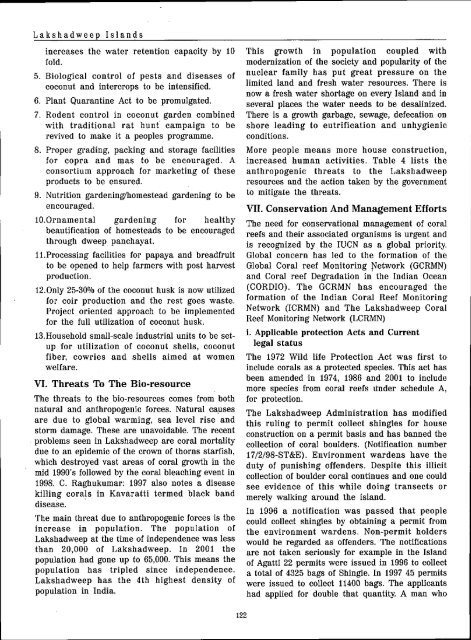06-bioresourcesstatu.. - M. S. Swaminathan Research Foundation
06-bioresourcesstatu.. - M. S. Swaminathan Research Foundation
06-bioresourcesstatu.. - M. S. Swaminathan Research Foundation
Create successful ePaper yourself
Turn your PDF publications into a flip-book with our unique Google optimized e-Paper software.
Lakshadweep Islands<br />
increases the water retention capacity by 10<br />
fold.<br />
5. Biological control of pests and diseases of<br />
coconut and intercrops to be intensified.<br />
6. Plant Quarantine Act to be promulgated.<br />
7. Rodent control in coconut garden combined<br />
with traditional rat hunt campaign to be<br />
revived to make it a peoples programme.<br />
8. Proper grading, packing and storage facilities<br />
for copra and mas to be encouraged. A<br />
consortium approach for marketing of these<br />
products to be ensured.<br />
9. Nutrition gardening1homestead gardening to be<br />
encouraged.<br />
10.0rnamental gardening for healthy<br />
beautification of homesteads to be encouraged<br />
through dweep panchayat.<br />
l1.Processing facilities for papaya and breadfruit<br />
to be opened to help farmers with post harvest<br />
production.<br />
12.0nly 25-30%of the coconut husk is now utilized<br />
for coir production and the rest goes waste.<br />
Project oriented approach to be implemented<br />
for the full utilization of coconut husk.<br />
13.Household small-scale industrial units to be setup<br />
for utilization of coconut shells, coconut<br />
fiber, cowries and shells aimed at women<br />
welfare.<br />
VI. Threats To The Bio-resource<br />
The threats to the bio-resources comes from both<br />
natural and anthropogenic forces. Natural ca)lses<br />
are due to global warming, sea level rise and<br />
storm damage. These are unavoidable. The recent<br />
problems seen in Lakshadweep are coral mortality<br />
due to an epidemic of the crown of thorns starfish,<br />
which destroyed vast areas of coral growth in the<br />
mid 1990's followedby the coral bleaching event in<br />
1998. C. Raghukumar: 1997 also notes a disease<br />
killing corals in Kavaratti termed black band<br />
disease.<br />
The main threat due to anthropogenic forces is the<br />
increase in population. The population of<br />
Lakshadweep at the time of independence was less<br />
than 20,000 of Lakshadweep. In 2001 the<br />
population had gone up to 65,000. This means the<br />
population has tripled since independence.<br />
Lakshadweep has the 4th highest density of<br />
population in India.<br />
122<br />
This growth in population coupled with<br />
modernization of the society and popularity of the<br />
nuclear family has put great pressure on the<br />
limited land and fresh water resources. There is<br />
now a fresh water shortage on every Island and in<br />
several places the water needs to be desalinized.<br />
There is a growth garbage, sewage, defecation on<br />
shore leading to eutrification and unhygienic<br />
conditions.<br />
More people means more house construction,<br />
increased human activities. Table 4 lists the<br />
anthropogenic threats to the Lakshadweep<br />
resources and the action taken by the government<br />
to mitigate the threats.<br />
VII. Conservation And Management Efforts<br />
The need for conservational management of coral<br />
reefs and their associated organisms is urgent and<br />
is recognized by the IUCN as a global priority.<br />
Global concern has led to the formation of the<br />
Global Coral reef Monitoring f"etwork (GCRMN)<br />
and Coral reef Degradation in the Indian Ocean<br />
(CORDIa). The GCRMN has encouraged the<br />
formation of the Indian Coral Reef Monitoring<br />
Network (ICRMN) and The Lakshadweep Coral<br />
Reef Monitoring Network (LCRMN)<br />
i. Applicable protection Acts and Current<br />
legal status<br />
The 1972 Wild life Protection Act was first to<br />
include corals as a protected species. This act has<br />
been amended in 1974, 1986 and 2001 to include<br />
more species from coral reefs under schedule A,<br />
for protection.<br />
The Lakshadweep Administration has modified<br />
this ruling to permit collect shingles for house<br />
construction on a permit basis and has banned the<br />
collection of coral boulders. (Notification number<br />
17/2/98-ST&E). Environment wardens have the<br />
duty of punishing offenders. Despite this illicit<br />
collection of boulder coral continues and one could<br />
see evidence of this while doing transects or<br />
merely walking around the island.<br />
In 1996 a notification was passed that people<br />
could collect shingles by obtaining a permit from<br />
the environment wardens. Non-permit holders<br />
would be regarded as offenders. The notifications<br />
are not taken seriously for example in the Island<br />
of Agatti 22 permits were issued in 1996 to collect<br />
a total of 4325 bags of Shingle. In 1997 45 permits<br />
were issued to collect 11400 bags. The applicants<br />
had applied for double that quantity. A man who










